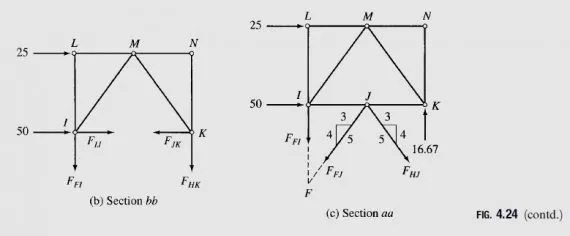Example 4.9
Determine the forces in members FJ; HJ, and HK of the K truss shown in Fig. 4.24(a) by the method of sections.
Solution
From Fig. 4.24(a), we can observe that the horizontal section aa passing through the three members of interest, FJ; HJ, and HK, also cuts an additional member FI, thereby releasing four unknowns, which cannot be determined by three equations of equilibrium. Trusses such as the one being considered here with the members arranged in the form of the letter K can be analyzed by a section curved around the middle joint, like section bb shown in Fig. 4.24(a). To avoid the calculation of support reactions, we will use the upper portion IKNL of the truss above section bb for analysis. The freebody diagram of this portion is shown in Fig. 4.24(b). It can be seen that although section bb has cut four members, FI; IJ; JK, and HK, forces in members FI and HK can be determined by summing moments about points K and I , respectively, because the lines of action of three of the four unknowns pass through these points. We will, therefore, first compute FHK by considering section bb and then use section aa to determine FFJ and FHJ.





